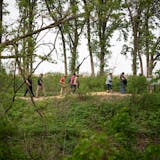Dr. Alison Raffman had only arrived in Bemidji two days earlier, with three boxes of stuff and two cats, and already she was hustling around the emergency department at Sanford Bemidji Medical Center.
The medical resident was treating dizziness in a newly diagnosed cancer patient, an infection in a nervous pregnant woman, and an irregular heartbeat in an elderly man struggling amid hearing loss and dementia to describe his symptoms.
And then there was Sandy Helberg in room 16, a 75-year-old who couldn’t stop her nosebleed. Raffman used her mobile phone’s flashlight to look up Helberg’s right nostril and throat.
“We’ll get a plan set in place to see what we can do to stop that bleeding, OK?” she assured her patient.
Raffman rotated to Sanford Bemidji for one month as part of a new effort by Hennepin Healthcare in Minneapolis to broaden the training of its residents — doctors fresh out of medical school who practice under supervision for three to four years before they can treat patients independently. The approach could be catching on nationally as hospitals try to solve the looming shortage of rural physicians.
Hennepin provides one of the nation’s premier residency programs for emergency medicine at HCMC in downtown Minneapolis, because few other hospitals can offer so much exposure to everything from traumatic injuries and drug overdoses to heart attacks and frostbite.
But while the training readies doctors to work in large trauma centers with every resource and specialist on hand, program leaders found it didn’t necessarily prepare doctors to serve in smaller ERs where they might need to do more on their own and stabilize patients for treatment elsewhere.
“My residency trained me to be an urban doctor,” said Dr. Meghan Walsh, director of HCMC’s residency programs. “The ability to stabilize a patient, and all that goes into that, is a very different practice pattern.”
![Three weeks ago, Octavio Rodriguez switched from making transmission parts to casting parts for hospital bed brake assemblies at Twin City Die Castings. ] GLEN STUBBE • glen.stubbe@startribune.com Thursday, April 9, 2020 How employee-owned Twin City Die Casting, which just laid off 40 production workers of its 250 employees in what was supposed to be a good year, is trying to accelerate its pivot to growing medical parts business for ventilators, hospital beds, etc as it copes with instan](https://arc.stimg.co/startribunemedia/WNZYKGTZ5IYMUCO3KI5TR3N7WI.jpg?&w=80&ar=1:1&fit=crop)

djoles@startribune.com As boaters flock to Minnesota lakes and rivers this holiday weekend for the unofficial kick-off to the boating season, they'll face more inspections in and out of the water as local cities and counties ramp up their work to stop the spread of invasive species. Across the metro, more boat accesses will be staffed by watercraft inspectors thanks to $10 million funneled to county government programs this year, up from $4.5 million the state allocated last year. ORG XMIT: MIN1505222156290209 ORG XMIT: MIN1506021218440580](https://arc.stimg.co/startribunemedia/34QSKO44B2XKVNUZCO5SLJQSLY.jpg?&w=80&ar=1:1&fit=crop)
